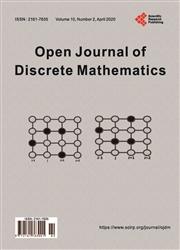The Tilings of Deficient Squares by Ribbon L -Tetrominoes Are Diagonally Cracked
引用次数: 9
Abstract
We consider tilings of deficient rectangles by the set T4 of ribbon L-tetro-minoes. A tiling exists if and only if the rectangle is a square of odd side. The missing cell has to be on the main NW-SE diagonal, in an odd position if the square is (4m+1)×(4m+1) and in an even position if the square is (4m+3)×(4m+3). The majority of the tiles in a tiling follow the rectangular pattern, that is, are paired and each pair tiles a 2×4 rectangle. The tiles in an irregular position together with the missing cell form a NW-SE diagonal crack. The crack is located in a thin region symmetric about the diagonal, made out of a sequence of 3×3 squares that overlap over one of the corner cells. The crack divides the square in two parts of equal area. The number of tilings of a (4m+1)×(4m+1) deficient square by T4 is equal to the number of tilings by dominoes of a 2m×2m square. The number of tilings of a (4m+3)×(4m+3) deficient square by T4 is twice the number of tilings by dominoes of a (2m+1)×(2m+1) deficient square, with the missing cell placed on the main diagonal. In both cases the counting is realized by an explicit function which is a bijection in the first case and a double cover in the second. If an extra 2×2 tile is added to T4 , we call the new tile set T+4. A tiling of a deficient rectangle by T+4 exists if and only if the rectangle is a square of odd side. The missing cell has to be on the main NW-SE diagonal, in an odd position if the square is (4m+1)×(4m+1) and in an even position if the square is (4m+3)×(4m+3). The majority of the tiles in a tiling follow the rectangular pattern, that is, are either paired tetrominoes and each pair tiles a 2×4 rectangle, or are 2×2 squares. The tiles in an irregular position together with the missing cell form a NW-SE diagonal crack. The crack is located in a thin region symmetric about the diagonal, made out of a sequence of 3×3 squares that overlap over one of the corner cells. The number of tilings of a (4m+1)×(4m+1) deficient square by T+4 is greater than the number of tilings by dominoes and monomers of a 2m×2m square. The number of tilings of a (4m+3)×(4m+3) deficient square by T+4 is greater than twice the number of tilings by dominoes and monomers of a (2m+1)×(2m+1) deficient square, with the missing cell placed on the main diagonal. We also consider tilings by T4 and T+4 of other significant deficient regions. In particular we show that a deficient first quadrant, a deficient half strip, a deficient strip or a deficient bent strip cannot be tiled by T+4. Therefore T4 and T+4 give examples of tile sets that tile deficient rectangles but do not tile any deficient first quadrant, any deficient half strip, any deficient bent strip or any deficient strip.带型L -四染色体对缺方的平铺是对角开裂的
我们考虑了带L-tetro-minoes的集合T4对缺陷矩形的tilings。当且仅当矩形是奇数边的正方形时,才存在平铺。缺失单元格必须位于NW-SE主对角线上,如果正方形为(4m+1)×(4m+1。瓷砖中的大多数瓷砖都遵循矩形模式,即成对瓷砖,每对瓷砖为2×4矩形。不规则位置的瓷砖与缺失的单元一起形成NW-SE对角裂缝。裂纹位于一个关于对角线对称的薄区域,由重叠在其中一个角单元上的3×3个正方形组成。裂缝把正方形分成面积相等的两部分。(4m+1)×(4m+1。T4对(4m+3)×(4m+3。在这两种情况下,计数都是通过显式函数实现的,该函数在第一种情况下是双射,在第二种情况下则是双覆盖。如果额外的2×2瓦片被添加到T4,我们称之为新瓦片集T+4。当且仅当亏矩形是奇数边的正方形时,存在T+4的亏矩形的平铺。缺失单元格必须位于NW-SE主对角线上,如果正方形为(4m+1)×(4m+1。瓷砖中的大多数瓷砖都遵循矩形图案,也就是说,要么是成对的四分之一瓷砖,每对瓷砖都是2×4的矩形,要么是2×2的正方形。不规则位置的瓷砖与缺失的单元一起形成NW-SE对角裂缝。裂纹位于一个关于对角线对称的薄区域,由重叠在其中一个角单元上的3×3个正方形组成。T+4对(4m+1)×。T+4对(4m+3)×(4m+3。我们还考虑了其他显著缺陷区域的T4和T+4的tilings。特别地,我们证明了缺陷的第一象限、缺陷的半条带、缺陷的条带或缺陷的弯曲条带不能通过T+4拼接。因此,T4和T+4给出了瓦片集的例子,其瓦片有缺陷的矩形,但不瓦片任何有缺陷的第一象限、任何有缺陷半带、任何有不足的弯曲带或任何有缺陷带。
本文章由计算机程序翻译,如有差异,请以英文原文为准。
求助全文
约1分钟内获得全文
求助全文

 求助内容:
求助内容: 应助结果提醒方式:
应助结果提醒方式:


